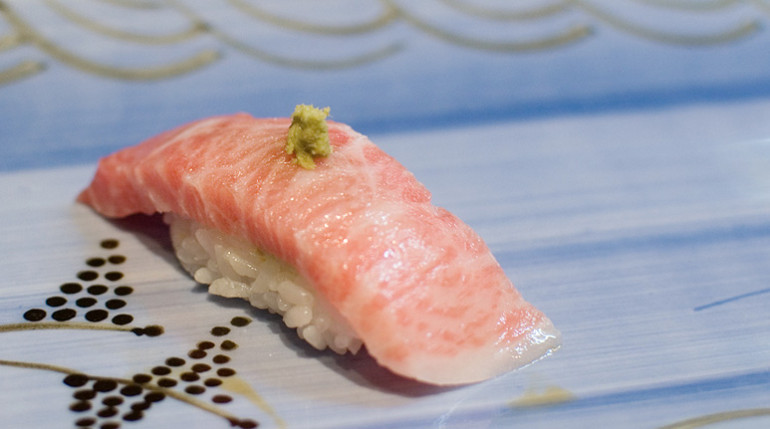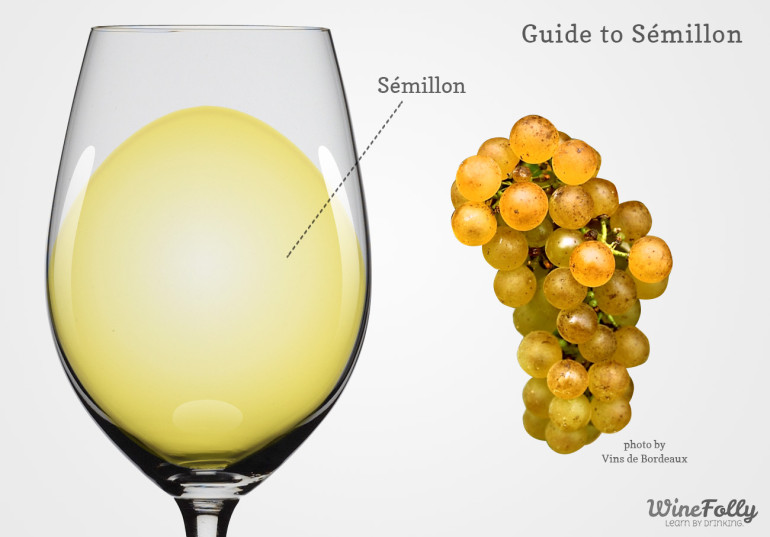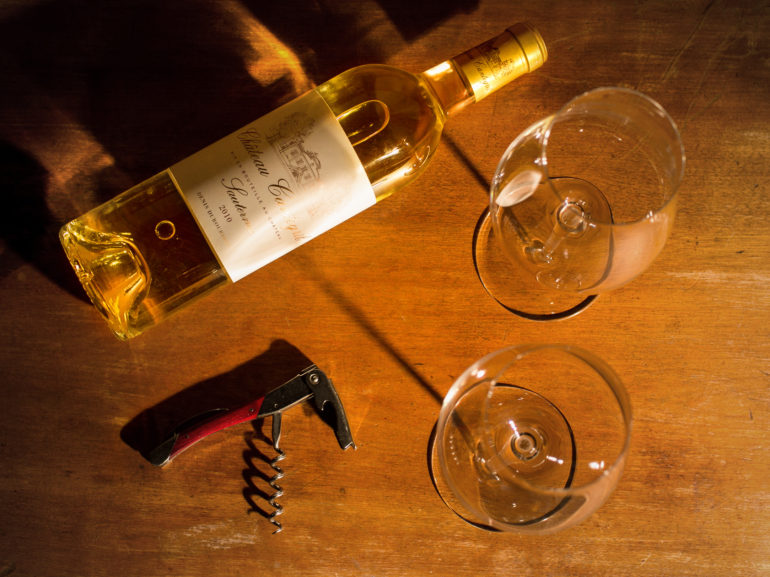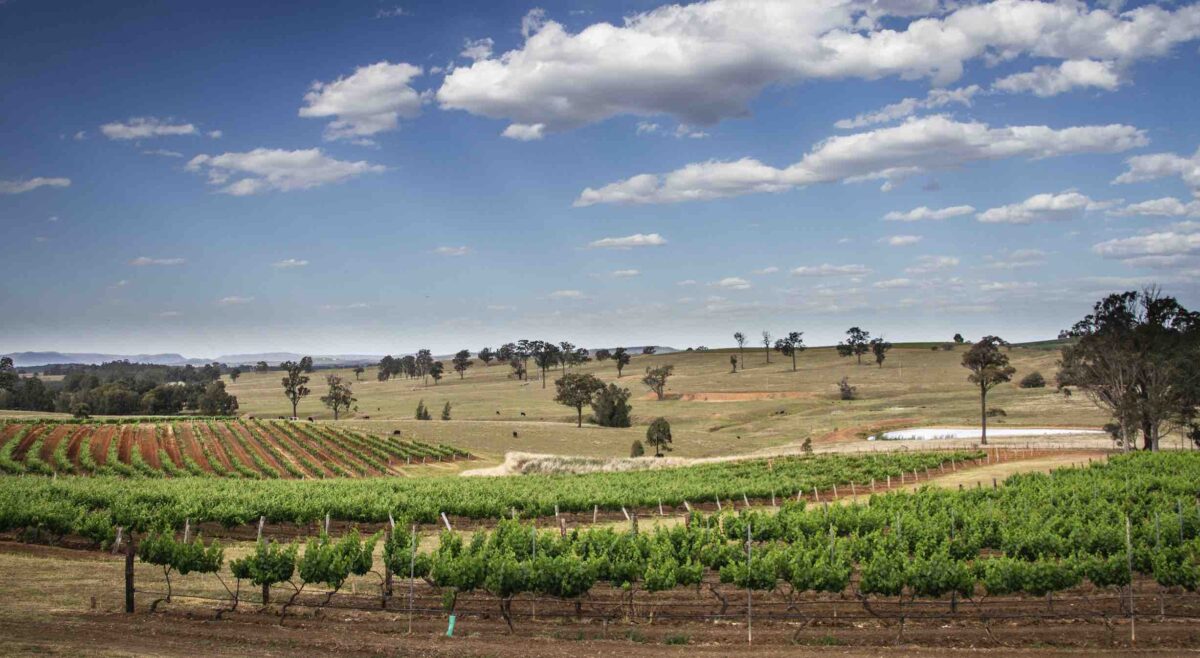Also known as: Wyndruif, Semillon
Table of Contents
Primary Flavors
- Lemon
- Beeswax
- Peach
- Chamomile
- Saline
Taste Profile
Sémillon is known for its high levels of aroma compounds, such as terpenes, which give it an alluring bouquet of beeswax, lanolin, and floral notes. The flavors range from fresh apple and citrus when young, evolving into richer flavors of honey, figs, and toasted nuts with age, somewhat reminiscent of Chardonnay.
On the nose, Sémillon offers a delightful play of fragrant citrus fruits mingled with undertones of dried grass and subtle minerality. If it matures in oak, expect vanilla, toast, and spice nuances to join the aromatic profile. In older Sémillons, you may discover intriguing layers of hazelnut, hay, and wax.
On the palate Sémillon typically shows refreshingly moderate acidity and a full-bodied texture that can be delightfully silky or almost oily. It leans toward the fuller side of the body spectrum, and its alcohol levels can range between 10-13.5%. In the case of sweet Sauternes-style wines, the viscosity and sugar content rise, offering an opulent and honeyed tasting experience.
How to Serve Sémillon Wine
Sémillon is best to drink slightly chilled, ideally between 45-55°F (7-12°C). This temperature brings out the nuanced flavors and aromas while preventing any alcohol sharpness from dominating. However, if serving sweet versions of Sémillon, chill it even more.
A standard white wine glass is a great choice for Sémillon, encouraging sufficient oxygen exposure to amplify its bouquet. In most situations, you will not need to decant Sémillon.
Sémillon showcases an impressive transformation with age. It transitions from fresh citrus and apple tones towards deep, complex notes of honey and toasted nuts. Most dry Sémillons can develop beautifully over 5-10 years, while sweet Sauternes-style Sémillon wines often have a life well beyond 10-15 years, sometimes surpassing 50 years in exceptional vintages.

SERVE
45–55°F / 7-12°C
GLASS TYPE
White
DECANT
No
CELLAR
5-10 Years
Sémillon Food Pairing
Thanks to the range of styles that Sémillon can create, it’s safe to say, whether you’re hosting a formal dinner or enjoying casual fare, there’s a Sémillon to match the mood and food.
Sémillon’s oily texture and nuanced yet complex flavors, ranging from apple to nuts, make it great for pairing with fuller-bodied or meatier fish dishes. For a truly divine combination, consider pairing it with sushi or a goat cheese salad.
Oaked Sémillons, with their richer palate, can step in nicely for Chardonnay, making them a great companion for roast chicken, creamy risotto, or Lobster Thermidor.
For sweeter styles, try the classic sweet-and-salty pairing of a slice of rich blue cheese or salted nuts.
Lighter, unoaked styles of Sémillon, like those from Hunter Valley, with their bright acidity, also do a stellar job cutting through the richness of dishes like salmon or mushroom risotto. Its vibrant citrus notes make it a natural pairing with shellfish.

5 Fun Facts About Sémillon
- One of the world’s most famous dessert wines, Sauternes, is made with mostly Sémillon grapes that have been affected by Noble Rot.
- Sémillon is commonly blended with Sauvignon Blanc worldwide – often called “White Bordeaux Blends.”
- Sémillon is highly adaptable to a range of vineyard climates, from warm to cool. This means a range of styles, from Riesling-like to Chardonnay-like, and dessert wines can be made.
- Sémillon has an unstable genome, which has led to several color mutations, including pink-skinned Sémillon Gris and red-skinned Sémillon Rose.
- Sémillon accounts for almost 50% of the white grapevines in Bordeaux.

Where it Grows
Sémillon hails from the Bordeaux region of France. It was the dominant white grape variety in Bordeaux. However, the onset of phylloxera in the late 19th century and the vine’s vulnerability to diseases led to a significant decline in its popularity.
Interestingly, Sémillon was introduced to Australia in the early 19th century, where it found a new lease on life. Today, the Hunter Valley region is renowned for producing some of the finest expressions of this grape.
In an unexpected twist, Sémillon also found a home in South Africa, where it was once the most widely planted grape. While its dominance has been surpassed by Chenin Blanc, Sémillon continues to contribute significantly to the Cape’s white wine legacy.
- France: 25,289 acres (10,234 hectares)
- Australia: 11,258 acres (4,556 hectares)
- South Africa: 2,770 acres (1,121 hectares)
- Chile: 2,100 acres (849 hectares)
- Argentina: 1,900 acres (767 hectares)
Total Vineyard Area – 46,191 acres (18,693 hectares) (data from 2021)

Bordeaux, France
What to expect: There are three major styles of Sémillon wines in Bordeaux: unoaked and zesty white dry wine found in Bordeaux Blanc, oaked, full-bodied, dry white wines found in Graves and Pessac-Léognan, and age-worthy, sweet dessert wines found notably in Sauternes. Most white Bordeaux Blends from Sémillon include Sauvignon Blanc to add freshness.
Sauternes: Sauternes is the jewel of Bordeaux’s sweet wine production. Sémillon here is affected by noble rot, resulting in wines of extraordinary concentration, complexity, and sweetness. Sauvignon Blanc is often blended in to increase acidity and freshness. Expect apricot, honey, and saffron notes interlaced with vibrant acidity and a creamy texture. The expression of Sémillon in Sauternes is truly unparalleled, showcasing its innate capacity for longevity and transformation.
Graves and Pessac-Léognan: These are full-bodied, dry, oaked, age-worthy white wines. Expect ripe apple, citrus, and pineapple flavors alongside grassy notes from the blending with Sauvignon Blanc. Vanilla notes from oak aging and creamy notes from malolactic fermentation are also standard. The best wines from Pessac-Léognan can age for a decade or more and are similar – in a way – to a high-quality white Burgundy.
Bordeaux Blanc: These are dry, refreshing, lighter styles of Sémillon and Sauvignon Blanc blends. They have lemon and grassy notes with passion fruit aromas. Crisp and refreshing, these are perfect for summertime drinking but are not meant for aging.

Australia
What to expect: Australia is the adopted home of Semillon (spelled without an accent here) and can be found throughout the continent. From Bordeaux-style blends in Margaret River in Western Australia to lean and crisp, yet immensely age-worthy styles in Hunter Valley, just north of Sydney, Australia displays as much, if not more stylistic differences in Semillon, than Bordeaux. You’ll also find delicious noble rot Semillon wines in Riverina, South Australia.
Hunter Valley: Hunter Valley Semillon is dry, lean, and crisp; if you like Riesling, you’ll find it very similar. When young, these wines are a bit “lean and mean,” but if you leave them for 5-10+ years, they become oily, nutty, smokey and waxy. They taste like they have oak aging but haven’t. They’re a bit like if fine white Burgundy was blended with Germany’s best dry Rieslings. Despite the subtropical climate, the wines have lower alcohol levels of 10.5%-11.5%, as the grapes are harvested early, and the region has a lot of cloud cover. If you can get examples with age, definitely try them out.

In-Depth Knowledge
Take a deep dive into understanding the complex nature of Sémillon.
Fungal Friends
The relationship between Sémillon and the Botrytis cinerea fungus, or noble rot, is a fascinating dance of nature that results in some of the world’s most luscious, sweet wines.
Sémillon’s thin skin and tight bunches make it particularly susceptible to this fungus. Noble rot develops when the morning mists of regions like Sauternes meet the afternoon sun’s warmth.
This fungus pierces the grape skins, leading to water evaporation, which concentrates the sugars, acids, and flavors within the berries. An intriguing outcome of this process is the development of sotolon, a potent aroma compound which contributes distinctive notes of honey, nuts, and spice to the wines. Sotolon is also in fenugreek, curry, caramel, and maple syrup.
The resultant wine has a sublime balance of intense sweetness and bright acidity, with complex flavors of apricot, honey, and saffron. This unique interplay between Sémillon and Botrytis showcases the grape’s extraordinary capacity for transformation, resulting in wines with remarkable longevity and character.

Winemaking Chameleon
Sémillon’s chameleon-like ability to present dramatically different flavor profiles, depending on winemaking techniques and region, is particularly evident when comparing dry Sémillon wines from Hunter Valley and Sauternes.
In the warmer Hunter Valley, producers often harvest Semillon early to preserve acidity. It is usually vinified in stainless steel tanks, avoiding oak and malolactic fermentation, resulting in a lean, crisp wine with green apple and citrus flavors. Over time, these wines undergo a stunning transformation due to the Maillard reaction, a form of non-enzymatic browning in foods like toasted bread. This reaction between amino acids and reducing sugars imparts complex flavors of honey, nuts, and toast.
Conversely, Sémillon often benefits from oak aging in Bordeaux and sometimes lees stirring. This enhances its natural texture and imparts an added layer of creamy, nutty complexity, resulting in a refreshing, full-bodied wine with flavors of citrus, wax, and minerality. These contrasting expressions of Sémillon highlight the grape’s versatility and ability to convey terroir.